Engaged in the clothing industry for 20 years.

Breaking the pattern: The apparel brands ditching trends and seasons
In an industry that thrives from constant change, a handful of fashion brands have broken away from convention to refine timeless apparel collections. Their seasonless business models proved notably resilient during the pandemic when many clothing companies suffered from overstock and supply chain woes. Could they serve as a viable alternative to overproduction and other wasteful practices that prevail in the fickle world of fashion?
Sometimes it takes outsiders to question norms that have been upheld for generations. Stockholm-based minimalist brand Asket was established in 2015 by August Bard Bringéus and Jakob Dworsky who were tasked with building a business plan in their last year of university. The idea was a simple one – they would only offer an essential wardrobe of garments that are truly needed and that customers could always return to.
Their motivation stemmed from the shared frustration they felt towards the clothes they saw on the market and the countless items in their wardrobe. “We just found that quite strange and inefficient. From a customer point of view, you’re very frustrated. You spend a lot of money on stuff that you don’t use,” says Asket’s co-founder Bard-Bringéus. “You buy things that you don’t feel comfortable in, that you’re not happy with. It’s either the quality or the style that at some point renders the garment obsolete.”
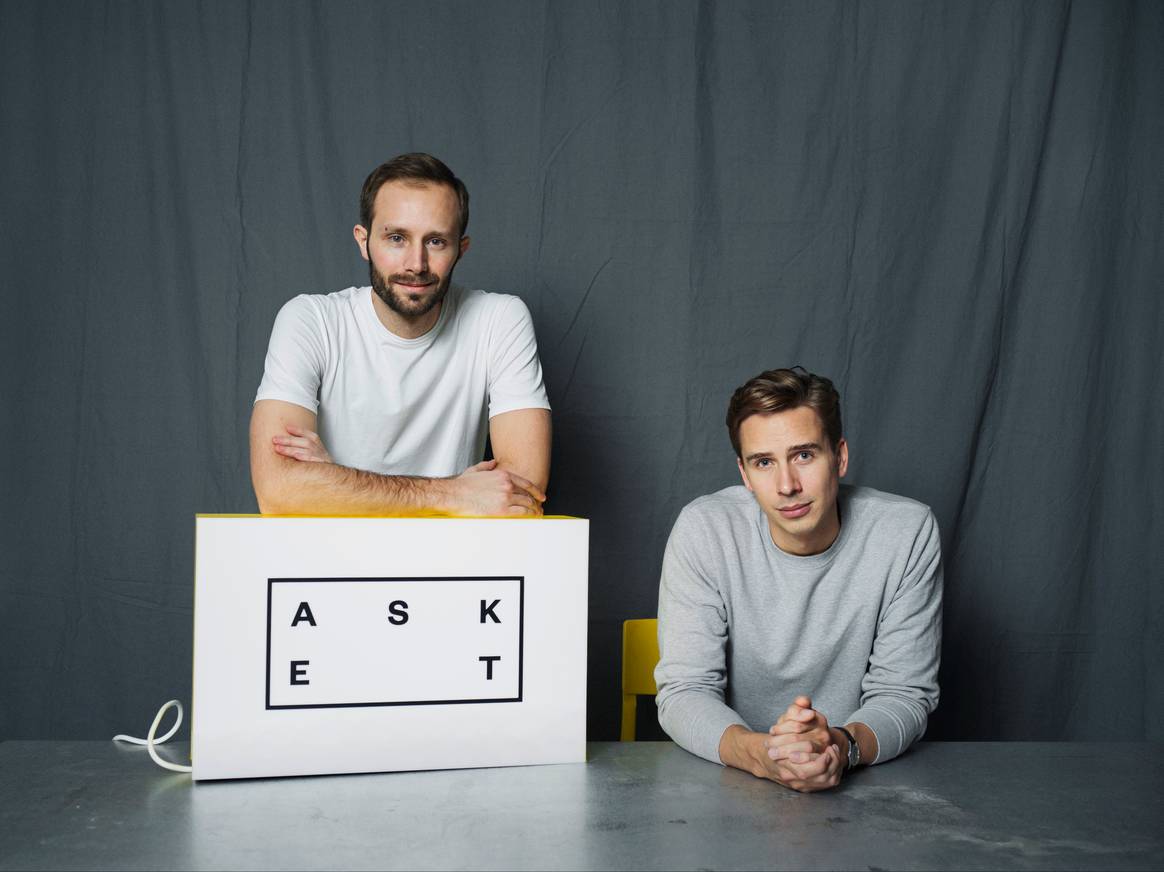
His irritation about the phenomenon of “planned obsolescence” is backed by data: In a report from 2017, the Ellen MacArthur Foundation estimated that worldwide clothing utilisation – or the average number of times a garment is worn before being discarded or no longer used – declined by 36 percent within 15 years, while clothing production has doubled to more than 100 billion items in the same period.
Trends are spinning ever faster
These figures highlight how wasteful the fashion industry and consumer behaviour have become. The emergence of fast fashion since the 1990s fueled the notion of apparel as a disposable good, while the rise of social media accelerated the dissemination of trends and pace of change in human desires, resulting in ever faster production cycles.
“With modern target groups, a trend is usually visible for six seasons,” explains Ulla Ertelt, head of Frankfurt-based market research firm HML Modemarketing. “From product launch to saturation and decline, a trend usually lasts three years.”
While many trends take several seasons to spread, fast fashion companies are adding newness on their shop floors much more frequently. The Spanish fashion chain Zara offers 24 new collections every year and its Swedish competitor H&M as many as 16, estimated a report by consultancy McKinsey in 2016. The brands don’t comment on the figures. Their business models proved so successful that more fashion brands increased the number of their collections from the traditional spring/summer and autumn/winter offers.
The Chinese digital-only retailer Shein even seems to drop new styles on its website daily, earning the moniker of ultra-fast-fashion company. The company didn’t provide figures when asked for comment but said that speedy on-demand production limits its overstock to single-digit percentages, while the fashion industry average is between 25 to 40 percent.
Choosing to defy the break-neck speed of churning out ever more items could seem outdated or at least puzzling. How can brands which disregard seasons and miss out on trends survive and even thrive in the current system?
Crafting timeless styles
One of the open secrets in the fashion industry is the fact that wardrobes in affluent countries are full. People own more clothing than ever before and are discarding them more quickly, studies by organisations such as Greenpeace show. Their wardrobes have grown so much that at least 50 percent of the clothes are never even worn. Fashion relies on pushing trends and other stimuli to keep selling in a saturated market, but the founders of Asket wanted to find an alternative.
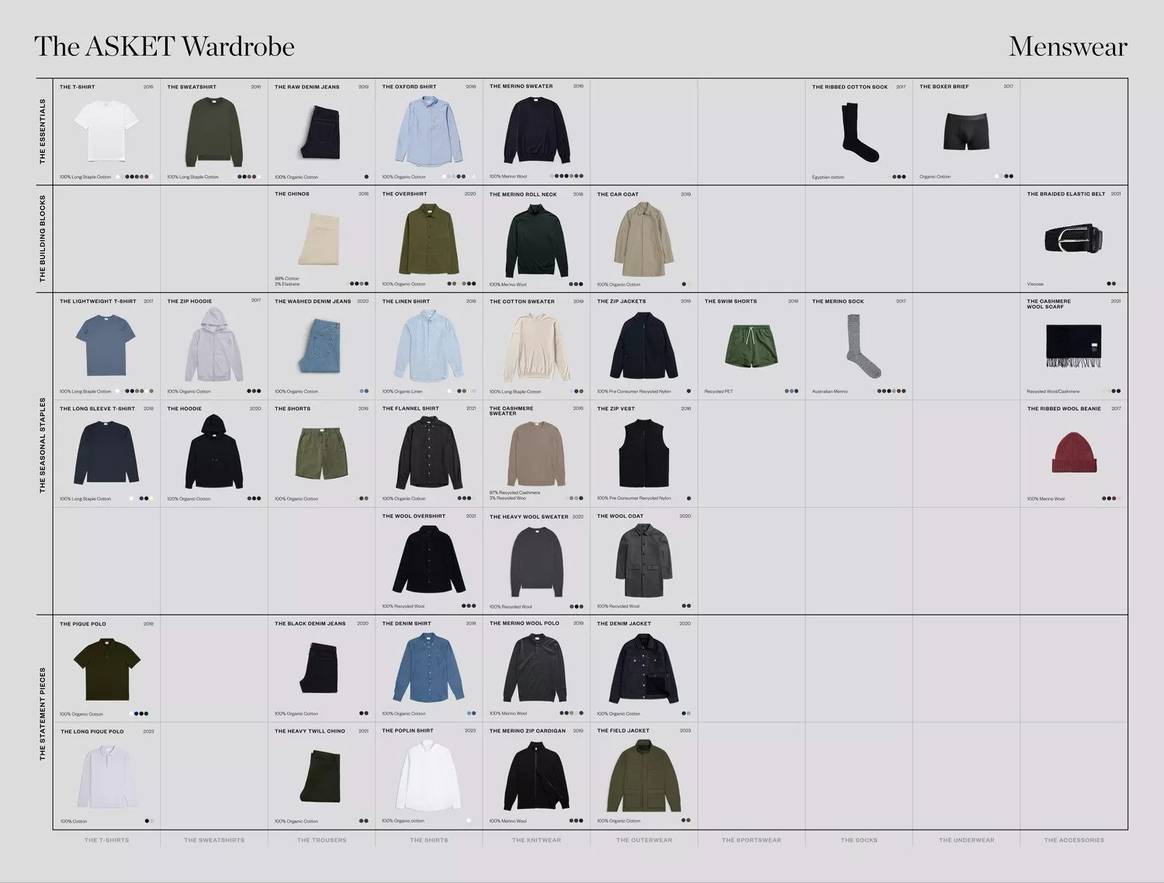
“Our idea was to look at the 20 percent of garments that we actually always use,” Bard-Bringéus says. “The garments we love day in and day out and that we’re going to use forever.”
Since its foundation, Asket has slowly and meticulously built a wardrobe of 41 styles in up to eight colours. “Timeless essentials” from menswear often share similar characteristics, explains the co-founder. They possess a function from military, athletics, workwear or uniforms and some are pop-culture icons like the white t-shirt popularised by actors such as Marlon Brando and James Dean.
“If we can’t find that garment historically, we know that it will not be very relevant in the future either,” he says.
The brand started from a simple white t-shirt in 2015 and gradually added items such as an Oxford shirt a year later and a pair of raw denim jeans in 2019. A women’s line launched in 2021 following the same recipe: Before Asket decides to add a garment to its offer, the heritage design is questioned and reworked from an utilitarian perspective.
As an example, Asket has removed coin pockets from its denim trousers in recent years because people don’t use coins as much anymore. Eliminating heritage design elements such as these also means cutting extra materials and costs – but Asket’s reimaging of the modern, practical garment doesn’t stop there.
Full focus on quality
One of the main issues in fashion or any sort of consumer product business is that companies compromise on the product, says Bard-Bringéus.
His company doesn’t only focus on the quality of garments before the launch such as choosing durable long-staple cotton for its t-shirts, it also keeps improving the items. Virgin cashmere in sweaters was eventually replaced by a recycled version, for example.
“If you only create very few garments, you have to be damn sure that customers are going to love that product. It doesn’t matter how much advertising money we spend, if people don’t love the product it’s not going to work,” Bard-Bringéus says.
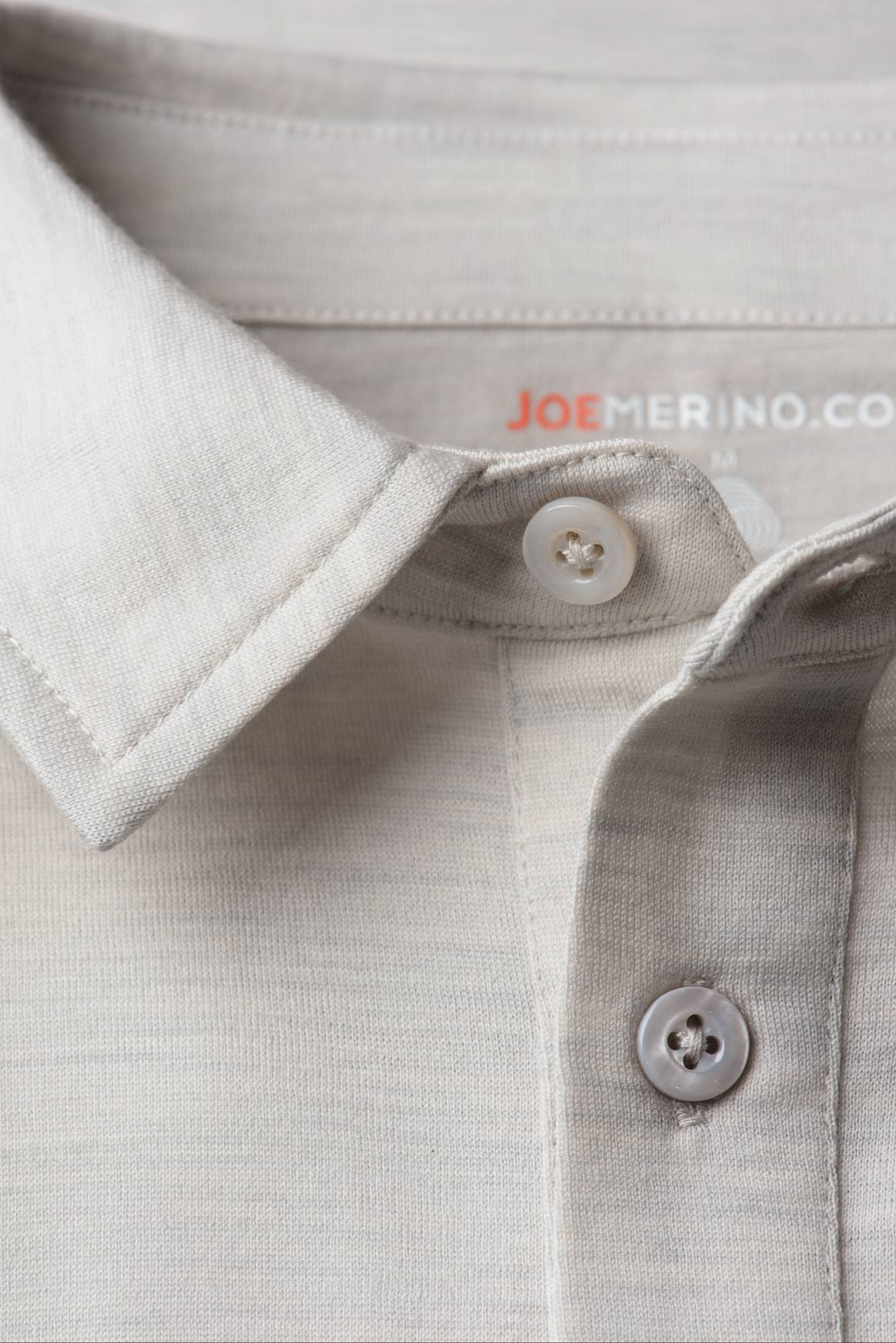
This approach – offering few, but well-made garments – is also adopted by other brands selling seasonless essentials and building loyal fan bases.
“We are not really in fashion. Of course, we make garments but we do not change too much. We just focus on quality, sizing, fit and listen carefully to our customer,” says Ron Beckers. He started his Amsterdam-based menswear label Joe Merino in 2011, focussing on high-quality wool essentials for men.
Timeless menswear
The fashion industry veteran used to run a women’s label for 20 years, but was happy to leave that segment because menswear doesn’t follow trends as heavily.
“In the basic shapes, it remains largely stable over many, many years. The skinny trend, for example, has been popular with fashionable men for more than eight years,” says Ulla Ertelt. “Menswear evolves over a longer term and this helps to facilitate the offering of timeless, seasonless fashion.”
These characteristics explain why most seasonless fashion labels have started and become successful in the menswear segment. However, it’s also still a smaller market, partly for the reason that items don’t become obsolete as quickly due to changing trends. In Europe’s biggest fashion market, Germany, men’s fashion only reaches half the sales of womenswear, according to Ertelt.
How big is the market for seasonless clothing?
Regional climate needs to be taken into consideration when gauging the size of the overall market for seasonless apparel. “The seasonal variations are about four months a year, which means about eight months a year you can pretty much wear the same types of garments here in Central Europe,” says Ertelt, who sees more potential for womenswear.
“For women, it’s a little more difficult because styles and fits are much more complex. But a higher percentage could be seasonless in many areas,” she added.
Tastes and styles differ from country to country, which consequently affects the size of the target group interested in timeless fashion. In Germany, about 50 percent of the items for women over the age of 30 could be timeless, says Ertelt. Many fashion companies focus on women between 30 to 40 but this group in the midmarket isn’t the biggest in terms of spending.
The biggest group is the so-called “classic women”, best described as being conservative with fashion trends and focused on quality, making up 50 percent of Germany’s womenswear market, according to Ertelt. And this group is already buying 50 percent of their clothing in recurring basic shapes and basic qualities.
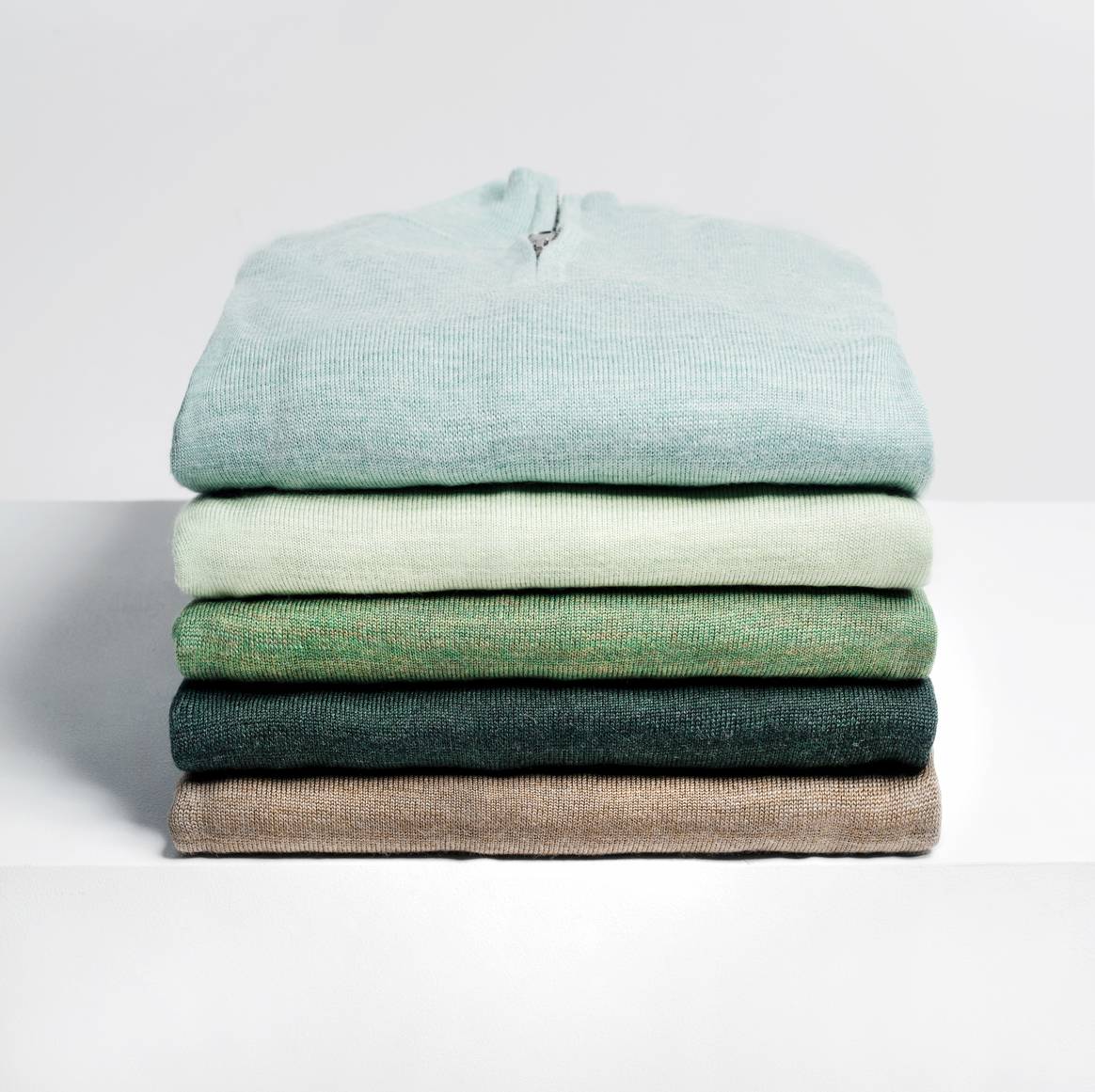
Retaining loyalty
The concept of seasonless apparel items isn’t completely new. Many fashion companies offer a never-out-of-stock line of timeless pieces to be purchased time and time again. This model also works best when customers can be retained permanently, for example, through fit as in the case with pants, explains Ertelt.
“Once a customer discovers them, she buys them for years under the name or label in different waist sizes or patterns, colours and qualities. That lends itself to a sustainable business model as customers make reliable purchases as an investment,” she adds.
Brands like Asket and Joe Merino have further evolved the concept of seasonless and never-out-of-stock pieces by building their whole business model around it. They convince customers with a consistent concept that offers reliable quality and fit.
“We have business all year, our customers are very loyal. People know what they buy, we deliver the same size every time, so customers are very confident to reorder,” says Ron Beckers. His brand can count on a loyal and returning base of around 75,000 active customers, with a strong standing in the Netherlands, Belgium and Germany.
Cutting out the middlemen
Having a stable base of returning customers also lends itself to a sleek online and direct-to-consumer business model with just a few own stores. Joe Merino operates four stores, Asket has two, mainly meant as spaces to present the brand as most of the business happens online. Foregoing wholesale – selling through other retailers via physical stores and online – means that a comparably high quality can be offered at a reasonable price.
From the beginning, Asket decided to have a three-times mark-up on costs to achieve the highest quality at the most reasonable price. Selling via wholesale channels would have increased the price for customers two- to threefold. The minimalist brand not only questions and eliminates design elements but the entire way conventional fashion business is done.
“That is how we look at our entire business model, our supply chain – cutting out the middlemen, agents, enormous store networks or distribution by wholesale,” says Bard-Bringéus. “All the stuff that doesn’t add value needs to go.”

A few years ago, Beckers declined a wholesale offer for Joe Merino from a department store – such offers are usually considered a sign of success and acknowledgement by many brands. “I will never do it again. I am so happy that I sell directly to the customers. That makes me happy every day.”
Stories not sales
Another commonality of seasonless brands is that they sell their products at full price, which is unusual in an industry that is plagued by overstock and relies on discounts to sell the items that are out of season or trend.
“In my former life, I was in ladies’ fashion, and we had to discount and sell a lot of old stock below cost price. Again and again,” said Beckers. “In my whole time with Joe Merino, I did not sell a single piece at a discount. My customers appreciate this because they don’t have the feeling that they bought the wrong thing or paid too much,” says Beckers. Clients only receive a discount when they buy more than one item, ranging from 10 to 45 euros.
A seasonless business model combined with never-out-of-stock items can be powerful. Retailers who stock Mud Jeans don’t have to discount the Dutch brand’s products because they don’t follow seasons and can always be re-ordered, says one of the owners Dion Vijgeboom. It also helps that Mud Jeans, which offers roughly 85 percent of its collection as never-out-of-stock items, doesn’t require minimum orders from retailers. “This is just to sort of counter the fast fashion movement and promote the way we do business and only sell what people need and not push too much,” he explains.
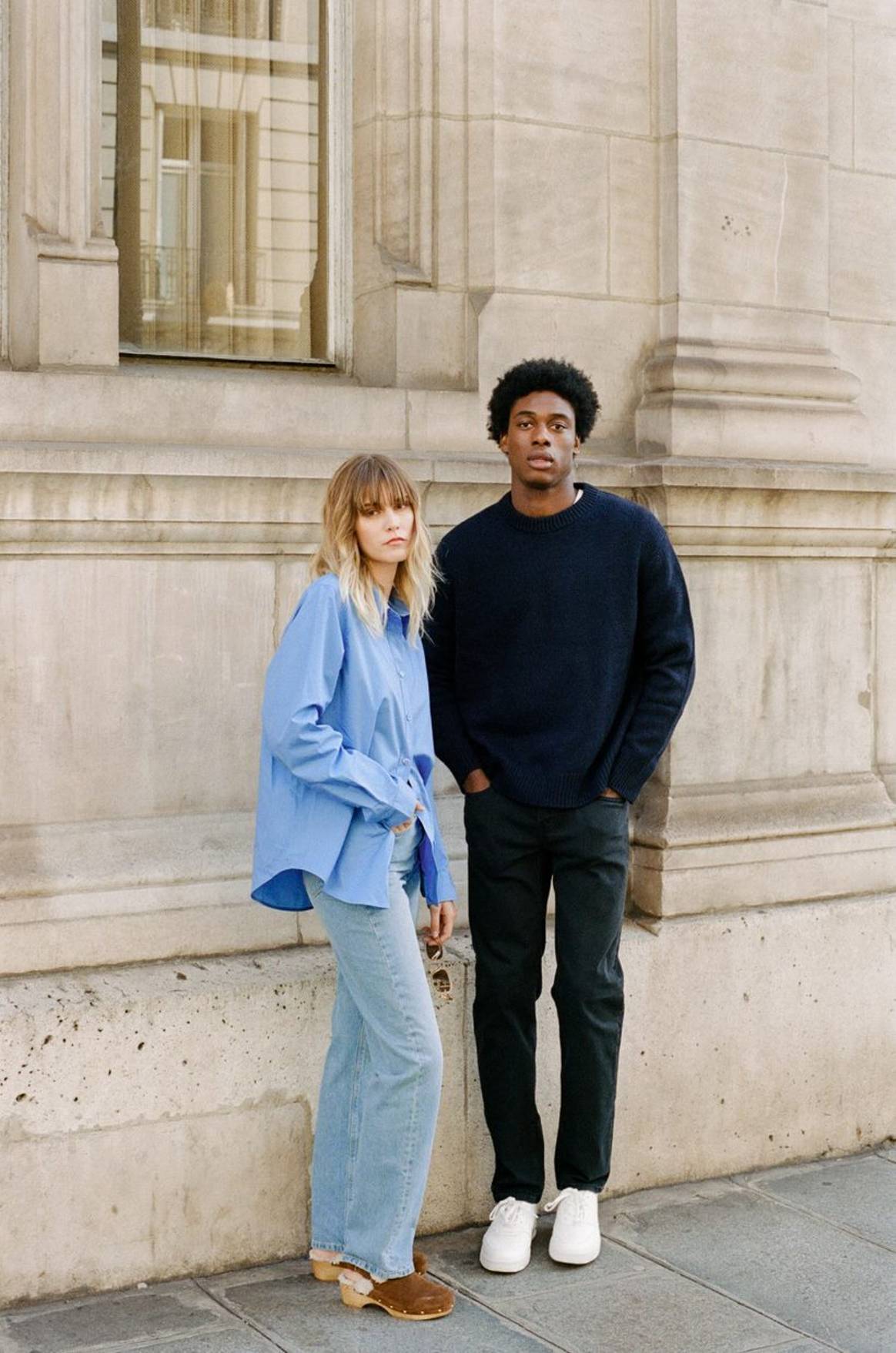
Instead of luring customers with trends or discounts during sales periods, marketing-savvy brands use their strong online presence to add newness by telling stories. As a pioneer in the field, Mud Jeans has much to share about its sustainable efforts. It sells organic cotton denim which, once reaching the end of its life, is recycled into material for new pieces. Additionally, the company says 40 percent of its customers already rent instead of buying jeans.
Phasing out styles
“We’re very strong online through our own shop. There, we can explain our story and our philosophy, we don’t only have to focus on our product,” says Dion Vijgeboom. But the denim brand does sometimes offer a few seasonal items “to give some sparks to the collections”.
And even with seasonless brands, styles sometimes don’t perform well for a long time. In this case, Mud Jeans will phase it out and consider introducing a new fit or wash.
The wool brand Joe Merino is also using smaller additions like a new colour to keep in touch with customers. “I have to tease my customers with new styles, new ideas and knowledge about sustainability for example,” says Beckers. “If a colour is not working so well, we don’t order it anymore or make a very small reorder.”
Stock and supply chains
A seasonless model, which directs customers away from seasonal discounted fashion, can also put the entrepreneurs behind the brands at ease when procuring raw materials. During the pandemic, major fashion companies cancelled orders with their suppliers as they reacted to collapsing demand. In contrast, brands like Joe Merino could even profit from lower wool prices and favourable currency developments because they dared to stock up. This also helped when demand recovered and many apparel brands ran out of stock.
“We didn’t stop investing in stock. I know a lot of companies froze new orders; we continued, we had good stock and could deliver. The main thing is that we were confident that our business would be ok,” Beckers recounts. “The only risk that I took is that I had less in my bank account and the other risk is that I sold the products slower. It’s not a big risk.”
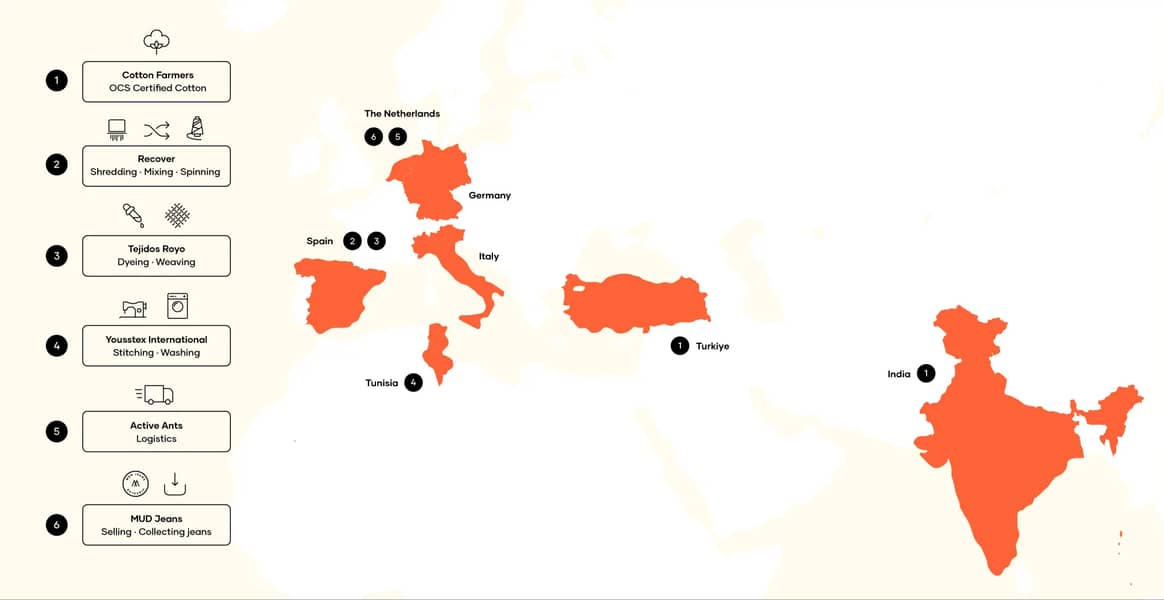
Conventional fashion companies could not be so relaxed in such highly uncertain situations as they are intrinsically tied to working with seasons and trends. Such companies would scramble to recuperate costs if too many items were produced and not sold, or only sold with heavy discounts.
Offering a limited amount of timeless styles can also help to create a quick and nimble supply chain as demonstrated by Mud Jeans. In contrast to common practice in the industry, the brand kept its supplier base small and close: The cotton comes from farmers in India and Turkey. One Spanish supplier is responsible for recycling and spinning, another supplies the fabrics. The denim brand is only working with six kinds of fabrics, allowing it to reach minimum order sizes quickly with one garment supplier in Tunisia. An order placed there would arrive in its Dutch warehouse within four weeks.
Forever improving
“From a supply chain point of view, we try to keep it as simple as possible,” Vijgeboom explains. “That is a conscious decision because that enables us to plan things very well.” A quick turnover in the supply chain puts less pressure on the finances of the brand and reduces the need of having a high stock in the Netherlands.
“When we started, we didn’t know yet that the greatest strength in our business model is the permanent collection per se”, says Asket co-founder Bard-Bringéus. “That is seemingly banal but when you think about it, that is what allows us to do everything differently.”
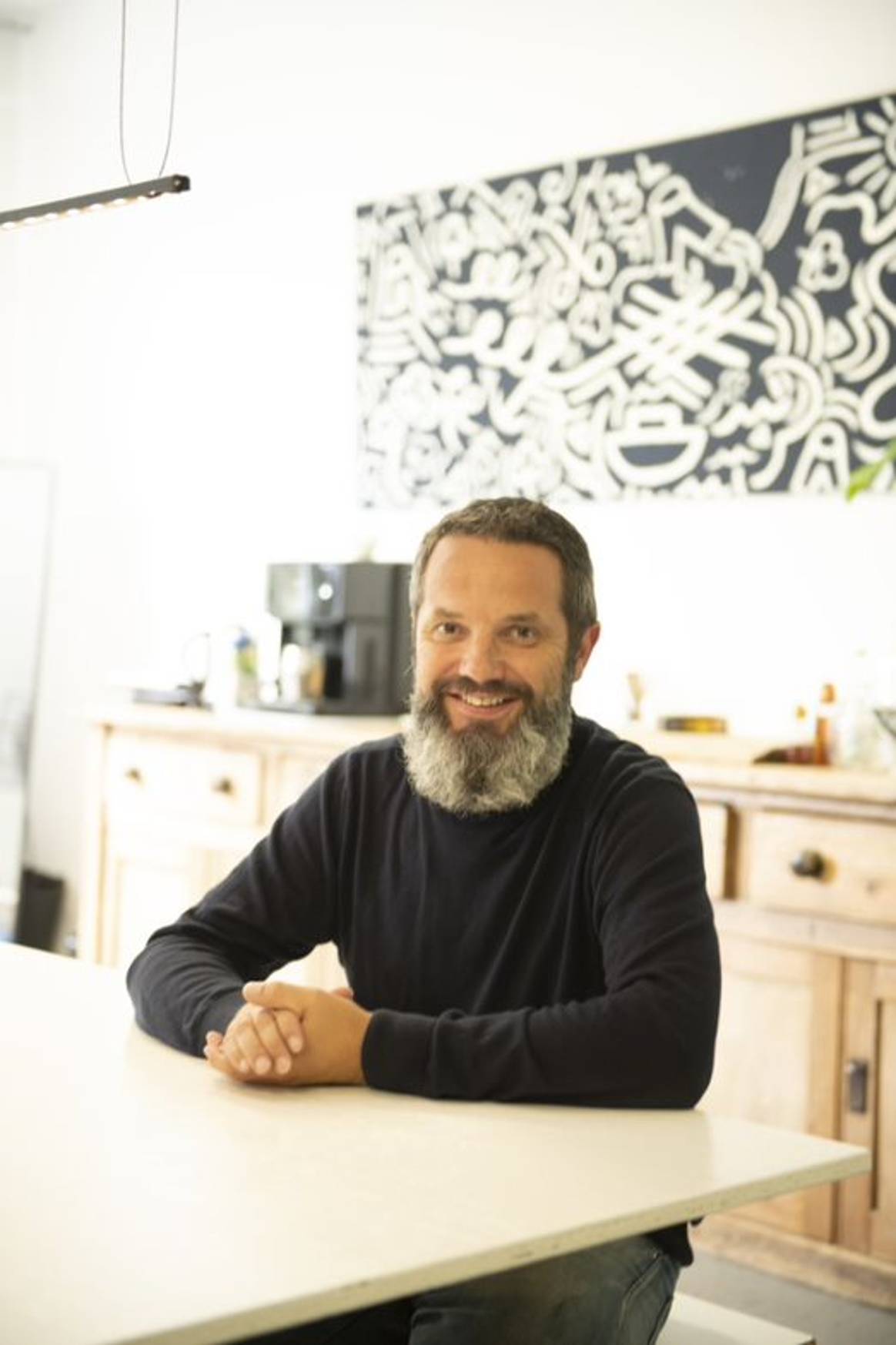
Brands with a permanent collection don’t face any limits to the amount of resources and time they can invest in perfecting their products because of their shelf life, he says. Asket introduced a full traceability system for its garments and also breaks down their costs to provide radical transparency for its customers. Mud Jeans has managed to close its own loop by making jeans that contain as much as 40 percent recycled denim – probably the highest degree of recycled content in apparel on the market so far.
“With a timeless fashion design, there can be cost savings related to design”, says Ertelt. On the production side, the consistent sell-through rates of timeless fashion can lead to steady utilisation of production facilities. This is also interesting for larger companies, she adds.
A niche business model?
Despite some obvious advantages and the continuous success of their business – Joe Merino shared that it achieves a “mellow” annual sales growth of as much as 30 percent, selling around 150,000 items per year currently – the question remains as to how far a seasonless approach can sustain the fashion industry in its current size and shape.
According to figures from Euromonitor, the sector reached 1,7 trillion US-dollars in sales in 2021. The size of the businesses with a permanent collection at their core are dwarfed by fashion giants such as Zara-owner Inditex or Swedish H&M Group, which rely on seasons and trends to sell millions if not billions of garments per year.
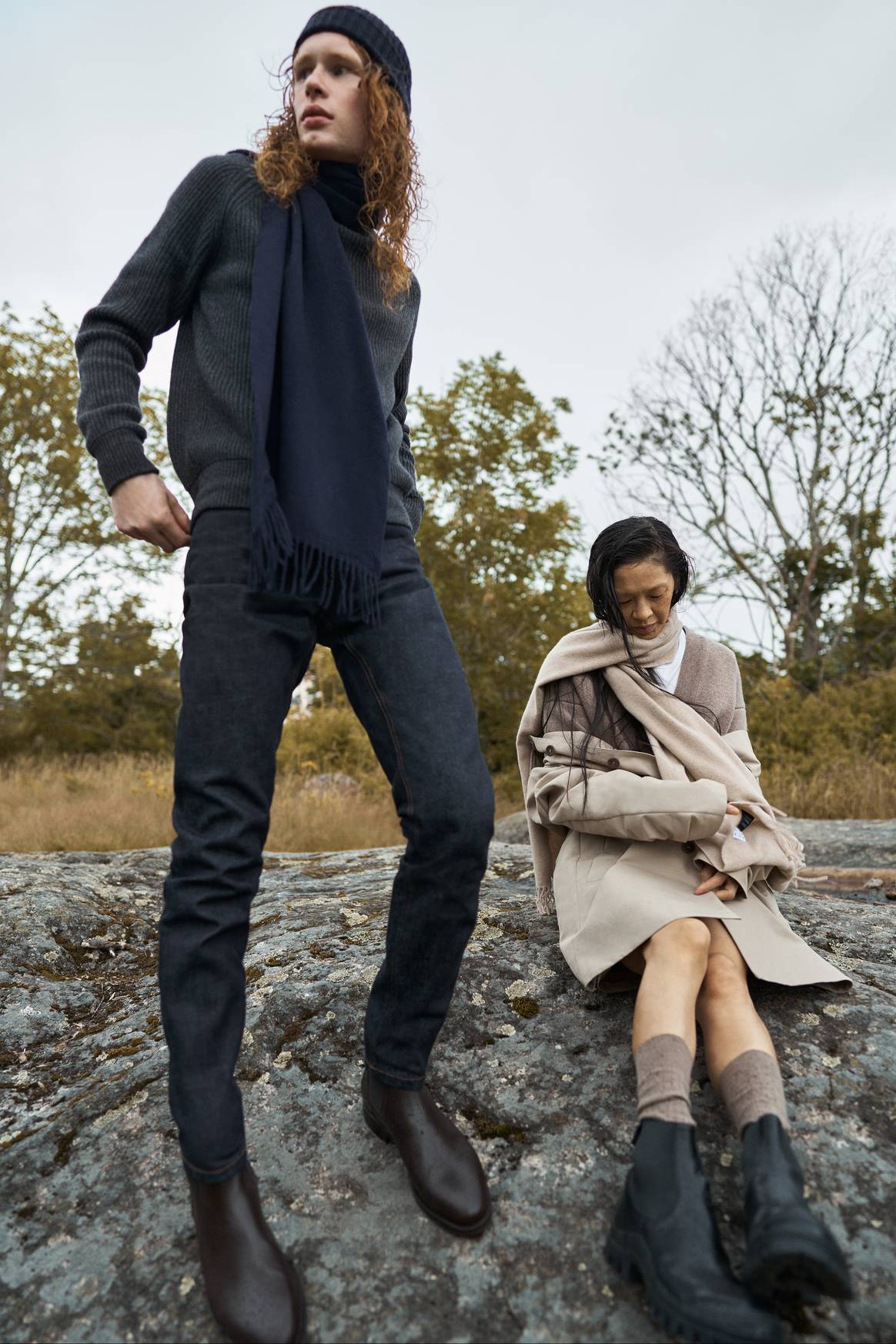
“Interestingly, it’s the fashion pieces that bring people through the store doors, but they end up buying more basics. From that perspective, individual brands could run a seasonless never-out-of-stock collection, but I don’t think the fashion industry per se can live on that,” says Achim Berg, partner at consultancy McKinsey. “Wardrobes in the Western world are full, and brands have to create desire for people to buy new pieces in the first place. That’s difficult with seasonless, more basic-oriented products.”
During the pandemic, seasonless brands proved to be resilient. When the fashion calendar came to a halt and shows were cancelled and questioned, unsold garments piled up as stores closed during repeated lockdowns and as demand slumped or shifted to cosy loungewear overnight. In the face of the apparent shortcomings, many working in the industry started to question the unsustainable ways business was being done.
Even though apparel companies started to build their online presence and more resilient local supply chains, fashion quickly reverted to business as usual. Efforts to become more sustainable increased, but it still remains to be seen as to how much these efforts will fall under greenwashing as the mechanisms leading to systematic overproduction remain largely untackled.
“There are, of course, opportunities for larger companies to introduce this timelessness as a style into the market. The buyer groups are there,” says Ertelt. “I’m convinced that in the long run, all fashion companies will have to work more sustainably in terms of development.”
A philosophical question
Despite the flaws in the current fashion industry, she points out that the answer to the question of how much and which kind of clothing we ultimately need is also a philosophical one.
A basic white t-shirt from Asket costs 40 euros. The brand justifies the price with higher quality – it’s indeed using long-stapled cotton fibres which are more durable. But not everyone might afford this mark-up on a basic cotton item which would only cost 12.99 euros (13.89 US-dollars) as a set of two at a clothing retailer like C&A.

“The average price per item in the timeless, sustainable fashion segment is 50 percent higher than the price that 50 percent of people in Germany spend on it,” says Ertelt.
One in two people in the country belong to the price-sensitive market segment where men spend an average of 160 euros and women 240 euros a year on clothing, according to her research.
Another aspect to note about labels like Joe Merino or Asket is that they built their permanent collections on classic items from a Western wardrobe, in a style that some might dub as “normcore”. These minimalist garments garnered a loyal following in Northern and Central Europe, but they might not appeal as much to people with different backgrounds or personalities to express their identity beyond the need for basic clothing.
However, many aspects of labels with business models built on a permanent collection remain relevant in the face of upcoming legislation such as the new textile strategy of the European Union.
“Many of us worked in the fashion industry before,” says Vijgeboom. “We’ve seen the pressure and greediness in this industry, that’s the last thing we want to promote.”